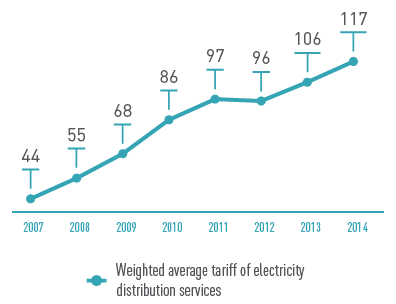Electricity Distribution
ROSSETI SDCs are engaged in electricity transmission and distribution in the regions of their operations and are responsible for a reliable and uninterrupted power supply.
|
Subsidiary/Dependent Company Name |
Delivery to Networks, |
Electricity Losses, |
Electricity Losses, |
|---|---|---|---|
|
IDGC of Centre |
64,175.5 |
5,949.2 |
9.27 |
|
IDGC of Center and Volga Region |
55,004.0 |
5,076.9 |
9.23 |
|
IDGC of Volga |
54,931.5 |
3,638.4 |
6.62 |
|
IDGC of North-West |
39,715.0 |
2,547.1 |
6.41 |
|
IDGC of Siberia |
74,766.2 |
5,668.8 |
7.58 |
|
TDC |
6,050.2 |
511.9 |
8.46 |
|
IDGC of Urals |
79,770.1 |
6,240.6 |
7.82 |
|
IDGC of South |
29,525.8 |
2,745.3 |
9.30 |
|
IDGC of Northern Caucasus |
18,058.7 |
3,572.8 |
19.78 |
|
Chechenenergo |
2,533.3 |
944.8 |
37.29 |
|
Kubanenergo |
21,572.7 |
2,852.7 |
13.22 |
|
MOESK |
88,764.9 |
7,784.6 |
8.77 |
|
LENENERGO |
34,208.4 |
3,791.5 |
11.08 |
|
Tyumenenergo |
73,403.2 |
1,868.2 |
2.55 |
|
Yantarenergo |
4,198.4 |
776.0 |
18.48 |
|
Total for distribution grids |
646,678.0 |
53,968.9 |
8.35 |
|
FGC UES** |
536,510.65 |
21261.0832 |
4.13 |
|
TOTAL for ROSSETI SDCs*** |
790,534.6 |
75,229.96 |
9.52 |
* The ROSSETI Group’s result takes account of ROSSETI SDCs’ subsidiaries and dependent companies engaged in electricity distribution.
** The calculation of FGC UES’s electricity losses is based on electricity delivery from FGC UES’s networks to customers’ electricity networks.
*** The calculation of the ROSSETI Group’s total result takes account of the electricity flow balance between electricity networks of FGC UES and electricity networks of ROSSETI’s subsidiaries and dependent companies engaged in distribution.
Reducing Electricity Losses
ROSSETI carries out the Consolidated Energy Conservation and Energy Efficiency Enhancement Program for 2011–2015.
The Company’s actual electricity losses were 75,229.955 million kWh, or 9.52% of electricity delivered to networks. Compared with 2013, electricity losses fell by 1,056.4 million kWh, or 0.14 percentage points. These indicators resulted from a package of measures taken by ROSSETI SDCs. The economic effect of reducing electricity loses totaled 5,219.8 million rubles.
Reduced energy consumption for business needs:
The economic effect of measures was as follows:
- 144.7 million rubles in distribution grids;
- 6.56 million rubles in transmission grids.
Major Facilities Connected to Electricity Networks
As part of ROSSETI’s contribution to Russia’s economic development, the Company continued in the reporting year to provide electricity connections for major facilities. The following facilities were connected to networks in 2014:
- new facility for the production of oil and gas pipes in the Kostroma Region (9.5 MW);
- 110/10-kV Titan Substation in the Middle Urals, which will supply electricity to industrial facilities in the Titanium Valley special economic zone;
- Beloyarsk NPP of Rosenergoatom (890 MW);
- Nyagan TPP of Fortum (420 MW);
- Novogorkovskaya CHPP (Units 1 and 2) of Integrated Energy Systems (180 MW);
- CHPP-16 of Mosenergo (420 MW);
- Abakan CHPP of TGK-13 (120 MW).
The Company improved electricity supply reliability for customers in Moscow and the Moscow Region (223 MVA of transformer capacity) and in Krasnoyarsk (801 MVA of transformer capacity and 23.7 kilometers of power lines).
Tariff Policy
The tariff policy in the electric grid sector has two principal goals:
- establish long-term stable parameters of regulation;
- provide competitive tariffs for the Russian economy.
At present, ROSSETI SDCs are subject to two long-term tariff regulation methods.
Return on Invested Capital Method (RAB)
Inherent in the method is the possibility of a phased payback plus interest on invested capital. Therefore, the benefits of the transition to RAB regulation are that returns are guaranteed, thus encouraging investment in grid infrastructure construction and modernization, and that it is possible to make more investments compared with the alternative tariff regulation method.
Long-Term Minimum Regulated Revenue Indexation Method
In the case of this method, the main components of minimum regulated revenue are controllable expenses and uncontrollable expenses, including expenses associated with depreciation of fixed assets and expenses related to using reinvested profit. Reinvested profit may not be in excess of 12% of a grid organization’s minimum regulated revenue.
The calculation base for electricity transmission and distribution services is the volume of electricity delivery and the amount of capacity determined in accordance with the Rules of Nondiscriminatory Access to Electricity Transmission and Distribution Services and the Provision Thereof and the consolidated forecast electricity (capacity) balance.
The weighted average pool tariff in the existing agreement system was 1.17 rubles per kWh in 2014, or 10% higher than in 2013.

